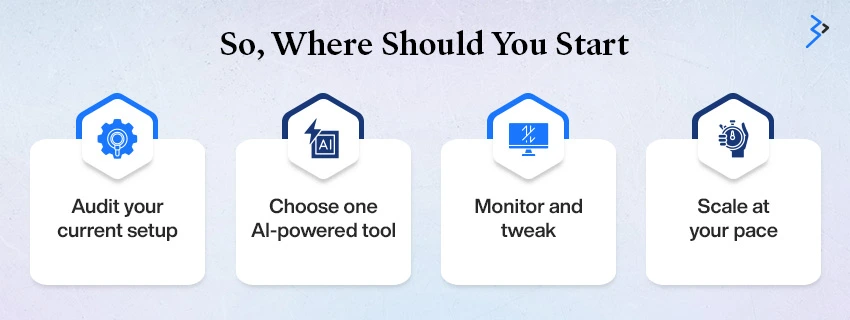Table of contents
1. The Modern Threat Landscape for eCommerce
2. Why eCommerce Security Needs to Evolve — Fast
3. AI for Fraud Detection: Your 24/7 Watchdog
4. Smarter Logins with Biometrics and Behavior Tracking
5. Real-Time Threat Detection: AI on High Alert
6. AI Doesn’t Work Alone: Human + AI = Power Team
7. But Wait—Isn’t AI Expensive?
8. The Mobile Twist: AI-Securing Your eCommerce App
9. Protecting Customer Data: AI as a Data Guardian
10. Building Customer Trust Through AI Security
11. Future Trends: What’s Next in AI-Powered Security?
12. So, Where Should You Start?
Final Thoughts: Security That Scales with Your Success
Frequently Asked Questions
There’s no second thought that the eCommerce world is booming, but so is cybercrime.
Let’s set the scene. Imagine it’s Black Friday. Your eCommerce app is buzzing. Orders are flooding in, carts are overflowing, and customers are happy. But somewhere, behind the scenes, a bot is mimicking real users—placing fake orders, scraping customer data, and injecting malicious code. And just like that, what should have been your biggest revenue day becomes your worst nightmare.
Sounds dramatic? Maybe. But for thousands of businesses, this scenario is all too real.
In today’s digital-first world, cyber threats are evolving at an unprecedented rate. And as eCommerce booms—especially on mobile—so do the opportunities for hackers, fraudsters, and bots to exploit vulnerabilities. The traditional “firewall and password” approach just doesn’t cut it anymore. Threat actors are using AI to launch attacks. So, it’s only fitting that AI becomes the weapon of choice for defense as well.
Here’s the truth: if you’re not thinking about AI-driven security, your competitors (and attackers) already are.
AI is no longer just a tool for marketing recommendations or chatbots. It’s a powerful shield—capable of real-time fraud detection, biometric authentication, behavioral analysis, and even predicting attacks before they happen. It’s like having a digital security team that never sleeps, never takes breaks, and gets smarter with every incident.
In this blog, we’ll explore how AI is reshaping security in eCommerce—from fraud prevention and secure logins to mobile app protection and real-time threat detection. You’ll discover how big brands are using it, and how you can too, whether you’re running a small Shopify store or a multi-national retail app.
Let’s dive into this evolving landscape and see how AI isn’t just protecting your platform—it’s protecting your future.
1. The Modern Threat Landscape for eCommerce
Remember when cyber threats were mostly about shady emails asking for your password or lottery winnings? That was the early 2000s. Fast forward to now, and it’s a whole different battlefield.
Today’s eCommerce platforms are under constant attack from highly sophisticated, AI-powered threats. We’re talking bot armies, credential stuffing attacks, deepfake scams, fake return frauds—you name it. And these aren’t just targeting the Amazons of the world. Small and mid-sized businesses are often the low-hanging fruit because their defenses are easier to bypass.
Here’s a chilling stat: In 2024, global eCommerce fraud losses reached $44.3 billion—and they’re projected to soar to $107 billion by 2029. As more shopping moves to digital and mobile, so do the scams. Every time your app welcomes a new customer, it becomes a more tempting target for sophisticated threats like AI-driven fraud. Want to stay ahead in 2025? Start by knowing the risks and how to fight back.
The rise of mobile commerce adds new challenges. Customers log in from airports, coffee shops, even moving cars—often using public Wi-Fi. Devices get stolen, apps get cloned, and malware gets smarter. It’s like a security nightmare wrapped in convenience.
And then there’s AI-powered cybercrime. Attackers are now using machine learning development to mimic human behaviors, bypass basic authentication, and automate large-scale attacks. They’re probing your systems 24/7, looking for that one crack in the armor.
Bottom line? The threat landscape isn’t just “evolving”—it’s mutating. Traditional security tools are reactive. They catch the attack after the damage is done.
That’s why proactive, AI-driven security is no longer optional. It’s the new baseline.
Your app doesn’t just need to survive the next cyberattack. It needs to outsmart it.
2. Why eCommerce Security Needs to Evolve — Fast
Let’s imagine you’ve built the perfect online store.
Your products are amazing. Your app loads in seconds. Your marketing is on point. And then… bam! A hacker bypasses your basic login system and scrapes sensitive customer info.
Result?
- Customers lose trust.
- You face potential lawsuits.
- Your brand reputation takes a nosedive.
The landscape has shifted. Basic security isn’t enough anymore. Hackers are no longer bored teenagers in a basement. They’re using AI-powered tools to launch smarter, faster, and more personalized attacks.
If they’re using AI, shouldn’t you fight fire with fire?
3. AI for Fraud Detection: Your 24/7 Watchdog
How it works:
AI fraud detection systems analyze millions of transactions, customer behaviors, and historical data points—often in milliseconds. They’re like Sherlock Holmes but faster and with zero tea breaks.
These systems can flag:
- Suspicious orders (e.g., buying 10 iPhones at 3 a.m.)
- Fake credit card usage
- Sudden spikes in purchase frequency from unusual IPs
Real-life example:
PayPal uses machine learning models that scan over 1,000 data points per transaction. These models detect subtle anomalies in buyer behavior that even seasoned fraudsters can’t mimic.
And the best part?
It learns continuously. As fraud techniques evolve, so does AI.
Quick thought:
Let’s say you run a boutique sneaker store. Suddenly, someone places an order for 20 pairs, ships them to an international address, and uses three different cards.
With traditional systems? That might get missed.
With AI? Alert triggered in seconds.
4. Smarter Logins with Biometrics and Behavior Tracking
Remember the days when passwords like “ilove123” felt secure?
Yeah, those days are gone.
Today’s eCommerce apps need smarter login systems—and AI is the key.
AI + Biometrics = Safer Logins
Face recognition, voice ID, fingerprint scanning—these aren’t just for spy movies. Your eCommerce app can use them right now.
And they’re backed by AI that:
- Learns user traits over time
- Adapts to changes (like aging faces or injured thumbs)
- Flags impersonation attempts
Behavior-Based Authentication
Even cooler? AI can track how you interact with your device:
- How fast you type
- How you swipe
- How you hold your phone
If something feels “off,” AI systems like BioCatch can deny access, even if the password is correct.
Real-life twist:
A major bank (which we can’t name) utilized AI behavior tracking and successfully prevented a massive breach in 2022. A fraudster had login credentials, but the AI flagged odd typing rhythms and location mismatch. Access denied. Millions saved.
5. Real-Time Threat Detection: AI on High Alert
Imagine having a digital bodyguard who never eats, sleeps, or blinks. That’s AI in real-time cybersecurity. It’s constantly scanning network activity, APIs, data transfers, and every user action, watching for anything suspicious.
So when something shady goes down—like a DDoS attack or a sneaky database injection—AI doesn't wait. It kicks into action instantly.
What does it do?
It isolates compromised systems, blocks shady IPs, alerts your security team, and even launches recovery protocols—all in real time. No delays. No second chances for attackers.
True story:
Shopify’s AI model, Hazel, scans millions of events every minute. In 2021, Hazel spotted an unusual spike in bot traffic imitating real users. Before they could scrape product listings or slow down the platform, Hazel shut them out.
That one move? It protected their revenue and kept customer trust intact.
Bottom line: Real-time AI threat detection isn’t just about stopping attacks—it’s about staying five steps ahead. If your eCommerce store isn't running with AI on alert, you're leaving the door wide open.
6. AI Doesn’t Work Alone: Human + AI = Power Team
Let’s be real—AI is a beast at analyzing data, but it’s not flawless. It can miss context or cry wolf with false positives. That’s where human intelligence steps in.
The smartest security strategy isn’t just AI—it’s AI plus skilled humans. Together, they form an unbeatable duo.
Read More - Beyond the Hype: Real-World Applications of AI in eCommerce Mobile Apps
Here’s how it works:
AI acts like your non-stop digital assistant, scanning millions of signals and flagging anything odd. But instead of overwhelming your team with alerts, it helps them cut through the noise, prioritize real threats, and zero in on what truly matters.
Security pros then step in with judgment, experience, and intuition—things AI hasn’t mastered (yet).
Think of it like this:
AI finds the needles in the haystack. Humans decide if those needles are dangerous or just bent out of shape.
This collaboration means faster response times, fewer false alarms, and stronger defenses overall. Because when machines and minds work together, your eCommerce platform becomes nearly bulletproof.
7. But Wait—Isn’t AI Expensive?
Here’s the twist—AI security doesn’t have to break the bank. In fact, it's way more affordable (and accessible) than most people think.
You don’t need a giant security team or custom-built systems. Today, plug-and-play AI tools are designed to slide right into your existing app or eCommerce platform—no drama, no massive spend.
Tools like:
- Darktrace for behavior-based threat detection
- Sift to catch fraud before it hits your bottom line
- PerimeterX to stop bots in their tracks
- Cloudflare’s AI firewalls for bulletproof API protection
These tools are built to grow with you. Whether you're a startup or scaling fast, you can add the protection you need without draining your budget.
So, now what? You don’t need deep pockets—just smart decisions. A little upfront investment in AI security now can save you from massive losses, downtime, and reputation damage later.
So no, AI security isn’t just for big tech. It’s for anyone who wants to sleep better at night.
8. The Mobile Twist: AI-Securing Your eCommerce App
Let’s zoom in on mobile apps development—where over 72% of eCommerce traffic happens.
Here’s where it gets tricky:
- People shop while walking, commuting, and even while half-asleep
- They connect through random Wi-Fi networks
- Mobile devices get lost all the time
AI helps secure mobile apps by:
- Monitoring app activity (like fake app installs or unauthorized access)
- Running real-time malware scans
- Using geofencing to detect access from unusual locations
Example:
Amazon’s mobile app uses anomaly detection algorithms to prevent fraud during one-click checkouts. If something feels “off,” users are prompted for extra verification without ruining the shopping experience.
That’s seamless security.
9. Protecting Customer Data: AI as a Data Guardian
Your customers hand over a lot—credit card numbers, addresses, and shopping history. That’s pure gold for hackers. One breach? It’s not just data lost—it’s trust shattered.
Enter AI: your behind-the-scenes guardian.
It encrypts everything, even while it’s being transmitted. It watches for unauthorized access attempts and catches shady database queries that could signal an internal breach.
But it doesn’t stop there.
AI also keeps an eye on insiders. If an employee is accessing more data than they should? AI flags it—fast. Because threats aren’t always on the outside.
Don’t forget the non-human side: secure your bots, APIs, and background jobs with service account security and strong controls for non-human identities (NHIs) to prevent silent abuse of automated access."
This isn’t just security—it’s reassurance. AI ensures your platform protects what matters most: your customers’ trust.
When shoppers know their data is safe, they come back. They buy more. They tell others.
So while AI’s guarding your data fortress, your brand reputation stays bulletproof.
10. Building Customer Trust Through AI Security
Security isn’t just a tech checkbox—it’s a trust builder and a brand booster.
When customers see features like facial recognition logins, real-time fraud alerts, and crystal-clear data protection policies, they feel secure. And when people feel safe, they’re far more likely to shop, share, and stay loyal.
Real-world proof?
Apple Pay exploded in popularity thanks to a triple layer of security—biometric login, tokenization, and AI-powered fraud detection. It wasn’t just secure; it felt secure. And that made all the difference.
AI doesn’t just guard your platform; it reassures your customers every step of the way. It tells them: “You’re safe here.”
In an era where headlines scream about data leaks and identity theft, visible AI security is a competitive advantage. It’s a reason to choose you over the next store.
So yes—secure really is sellable.
11. Future Trends: What’s Next in AI-Powered Security?
Ready to see where AI security is headed?
Spoiler: it’s smarter, smoother, and way ahead of the curve.
Predictive Threat Modeling
Forget reactive defense—AI will soon predict threats before they strike. By scanning trends, traffic patterns, and even dark web chatter, it could foresee phishing campaigns or botnet attacks before they go live.
Adaptive Authentication
Say goodbye to static logins. AI will adapt based on risk levels:
- Low risk? Quick one-tap access.
- High risk? Bring on facial scans, OTPs, and behavior checks.
AI-Driven Data Masking
Sensitive data will stay hidden—even from insiders. Artificial Intelligence Development Service will anonymize information in real time, keeping it safe from leaks, devs, and third-party tools.
The future of AI security isn’t clunky or intrusive. It’s invisible, intuitive, and built right into the user experience. The goal? Keep your platform ironclad without ever slowing things down.
Security will no longer be a barrier—it’ll be a built-in advantage.
12. So, Where Should You Start?
Feeling overwhelmed? Totally normal. But here’s the good news—you don’t have to do everything at once.
Start small. Start smart. Here’s your AI security roadmap:
- Audit your current setup: What are your biggest vulnerabilities—weak login flows, suspicious traffic, unsecured APIs?
- Choose one AI-powered tool: Focus on a high-impact area like fraud detection or login security. Tools like Sift or Cloudflare can plug right in.
- Monitor and tweak: Let the AI learn from your environment. Fine-tune based on real data and behavior.
- Scale at your pace: As your app grows, bring in more AI tools—threat detection, data masking, insider risk alerts.
Remember: Security is a journey, not a sprint.
Each step you take with AI makes your platform smarter, stronger, and more trustworthy.
Start where you are, use what you have, and grow from there. Your future self—and your customers—will thank you.
Read More - More Than Just Suggestions: How AI Is Deepening Customer Connections in eCommerce
Final Thoughts: Security That Scales with Your Success
If you take one thing away from this—let it be this:
AI-driven security isn’t just about preventing damage. It’s about building trust, reputation, and long-term success.
Your eCommerce app is more than just code and inventory. It’s your brand. Your promise. Your livelihood.
Start small. Integrate one AI-based fraud tool. Add biometric login. Monitor in real-time. Grow from there.
Because when your customers feel secure, they come back. They spend more. They tell their friends.
And that’s how you build not just a store—but a legacy.
Still got questions? Or want help figuring out what tool to start with?
Let’s talk. We’re here to help you build safer, smarter, and stronger eCommerce experiences.
Frequently Asked Questions
1) Why is AI important for eCommerce security?
AI helps detect and respond to threats in real time, automatically identifying suspicious behavior, blocking fraud attempts, and protecting sensitive customer data—far faster than manual monitoring.
2) Can small businesses afford AI security tools?
Yes! Many AI-powered security tools are plug-and-play and scalable, meaning you can start small and add more features as your business grows, without a huge upfront cost.
3) What kind of threats can AI detect in real time?
AI can detect DDoS attacks, bot traffic, unauthorized access, phishing attempts, data breaches, and even insider threats, giving you instant alerts and response options.
4) How does AI help protect customer data?
AI encrypts data during storage and transmission, monitors database access for anomalies, and flags unauthorized data usage, including internal misuse, to keep customer information safe.
5) Is AI alone enough to protect my business?
No—AI is powerful, but combining it with human expertise is key. Together, they reduce false positives, prioritize threats, and build a proactive, adaptive security posture.
Related Articles
Digital Transformation
Hyper-Personalized Banking: Driving Customer Loyalty and Engagement with AI-Powered Adobe Experiences
Digital Transformation
Leveraging 3rd Party LLMs: A Guide to Commercial AI Platforms
Digital Transformation
Integrating Content and Commerce with AI: Turning Every Mobile Touchpoint into a Revenue Opportunity






